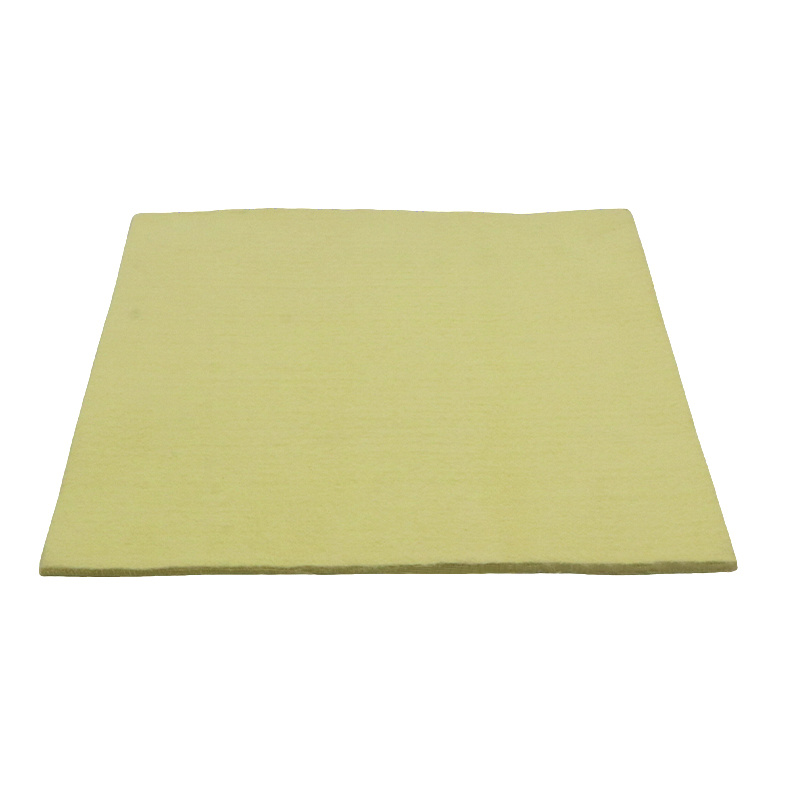Aramid 1414 nonwoven fabric is used in industrial high-temperature protective clothing.
Oct 16,2025

Aramid nonwoven fabric is a type of nonwoven material made from aramid fibers using nonwoven processes such as the wet-laid, needle-punching, or hydroentangling methods.
Aramid fibers (such as DuPont's Kevlar®): Known for their high strength and modulus, they are commonly used in bulletproof armor.
Kaidun New Materials boasts a professional needle-punching machine production line and fully automated manufacturing equipment, offering customized aramid 1414 non-woven fabrics in a variety of specifications, sizes, and basis weights. As an original-source factory for fire-resistant cotton with 13 years of industry experience, we guarantee superior quality.
Characteristics of Aramid Nonwoven Fabric
1. Excellent flame retardancy and thermal stability
Non-melting and non-dripping: At extremely high temperatures, it neither melts nor forms molten droplets—instead, it only chars, effectively preventing secondary burns.
Fire self-extinguishes: With a limiting oxygen index (LOI) exceeding 28%, it is difficult for the material to sustain combustion in air.
Good thermal stability: Aramid nonwoven fabric can be used continuously in environments exceeding 200°C, and it can withstand short-term thermal shocks of over 250°C.
Low thermal shrinkage: Minimal dimensional change at high temperatures.
2. High Strength and Durability
Para-aramid nonwoven fabric boasts a high strength-to-weight ratio, offering exceptional toughness, wear resistance, and superior tensile and tear strength.
3. Excellent chemical stability
It can resist erosion from most organic solvents, oils, and chemicals, and exhibits excellent hydrolytic stability.
4. Electrical Insulation
It remains highly resistant to dielectric breakdown even under high-temperature and high-voltage conditions, making it an excellent insulating material.
5. Lightweight, soft, and highly adaptable
Products can be manufactured in various thicknesses, weights, and levels of softness as needed, offering flexible application options. Customization is also available.
Applications of aramid nonwoven fabrics
In the market, aramid nonwoven fabrics are processed into various forms depending on their intended use:
Aramid needle-punched felt: Produced by a needle-punching process that interlocks the fibers, resulting in greater thickness and high loftiness. It is primarily used for high-temperature filter bags.
Aramid spunlace fabric: smooth and soft to the touch, commonly used for both inner and outer layers of high-end protective clothing.
Aramid insulation paper/wet-laid nonwoven fabric: extremely thin and uniform, primarily used for electrical insulation, such as motor insulation paper and motor slot insulation.
Aramid short-cut fiber mat: Used as the reinforcing framework for composite materials.
Aramid composite felt/blanket: Combined with other materials such as ceramic fibers and pre-oxidized fibers to achieve more comprehensive high-temperature performance.
1. Security Protection Field
Aramid nonwoven fabric, serving as the core insulation layer, is used in firefighter suits, industrial high-temperature protective clothing (such as those worn in welding, metallurgy, and glass manufacturing industries), and military protective gear. When exposed to extremely high temperatures or flames, aramid nonwoven fabric neither melts nor drips, effectively blocking heat transfer and providing critical life protection for emergency responders, industrial workers, and soldiers. Additionally, common fire blankets and escape blankets are also made from this material.
2. High-Temperature Filtration Field
In today's environmentally stringent era, aramid nonwoven fabric is the core filtration material for high-temperature baghouse dust collectors. It is fabricated into filter bags used in flue gas treatment systems at cement plants, coal-fired power plants, and waste incineration facilities. Capable of enduring temperatures exceeding 150°C—or even up to 200°C—for extended periods, this material also resists corrosive dust, effectively capturing fine particulate matter to achieve low emissions. As such, it has become a critical component in industrial exhaust gas management.
3. Electrical Insulation Field
In the fields of power and propulsion, aramid nonwoven fabrics—particularly the thin-grade insulation papers—are exceptional H-class (180°C) and higher-level insulating materials. They are widely used in wind turbines, high-speed rail traction motors, electric drive motors for new-energy vehicles, transformers, and premium-grade wires and cables, serving as slot insulation, phase-to-phase insulation, and more. These materials ensure that critical electrical equipment operates reliably, safely, and efficiently—even under extreme conditions such as high temperatures and high voltages—for extended periods.
4. Aerospace and Transportation Sector
To meet extremely stringent flame-retardant safety standards, aramid nonwoven fabrics are extensively used in the interiors of aircraft, high-speed trains, and premium passenger coaches—such as seat upholstery, wall panels, ceilings, and thermal/sound-insulation layers. In the event of a fire, these materials effectively prevent flames from spreading, buying precious time for passengers to evacuate safely. They are an indispensable component in ensuring public transportation safety.
5. New Energy and High-Tech Fields
With the advancement of technology, aramid nonwoven fabrics are playing an increasingly prominent role in emerging fields. In new-energy vehicles, they are used as thermal insulation sheets within power battery packs, preventing a single cell from triggering a chain reaction that could compromise the entire pack in case of thermal runaway—thus significantly enhancing the safety of the battery system. Meanwhile, they also serve as the reinforcing framework for high-performance composite materials and as high-temperature sealing gaskets, continually expanding the boundaries of their applications.
Related Posts
Contact Us
E-mail:
gdkaidun@163.com
Phone/WeChat:
86-131-3828-6677
Address:
Room 401, Building 21, No. 1, Keqing Road, Yundonghai Street, Sanshui District, Foshan City, Guangdong Province





